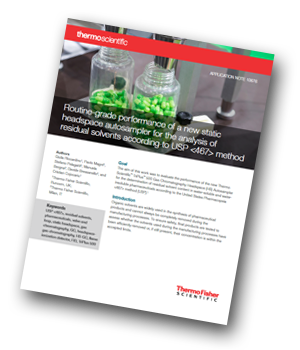Thermo Fisher Scientific has produced an application note with the goal of evaluating the performance of a new Thermo Scientific™ TriPlus™ 500 Gas Chromatography Headspace Autosampler for the determination of residual solvent content in water-soluble and water-insoluble pharmaceuticals according to the United States Pharmacopeia method.

 Organic solvents are widely used in the synthesis of pharmaceutical products and cannot always be completely removed during the manufacturing processes. To ensure safety, final products are tested to assess whether the solvents used during the manufacturing processes have been efficiently removed or, if still present, their concentration is within the accepted limits.
Organic solvents are widely used in the synthesis of pharmaceutical products and cannot always be completely removed during the manufacturing processes. To ensure safety, final products are tested to assess whether the solvents used during the manufacturing processes have been efficiently removed or, if still present, their concentration is within the accepted limits.
As organic solvents have relatively low boiling points and are thermally stable, the analytical method of choice for Class 1 and 2 residual solvent determination is static headspace sampling coupled to gas chromatography, with either flame ionization detection or mass spectrometry as detectors of choice. Class 3 solvents can also be determined with a nonspecific method such as weight loss on drying. Headspace sampling allows for the extraction of semivolatile and volatile compounds from complex liquid and solid matrices in a fast and simple way without the need for time-consuming sample preparation.
The new Triplus 500 HS autosampler offers an innovative design of the pneumatic circuit with a direct connection between the heated valve and the GC column. This translates into highly precise sample introduction and excellent peak area repeatability. Additionally, continuous purging of the sample path ensures system robustness and reliability reducing the risk of contamination and carryover (important when high boiling residual solvents are analysed). In this study, the results from the analysis
of residual solvent according to the USP <467> criteria obtained with the TriPlus 500 HS autosampler and
FID as detector of choice are reported. USP <467> system compliance, sensitivity, precision, robustness,
and linearity were assessed according to the workflow described in the USP <467> method for both water- soluble and water–insoluble pharmaceutical products.
Conclusion
The results presented in this work demonstrate that the new TriPlus 500 HS autosampler in combination with the Trace 1310 GC and FID detector delivers the outstanding performance for the analysis of residual solvents in pharmaceutical products meeting or exceeding all USP <467>method requirements.




